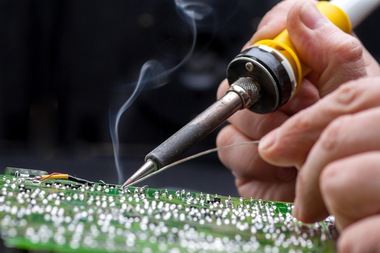☰ Menu
Menu

If you want to get into electronics design or manufacturing, learning to solder is a must-have skill. But for beginners, soldering can seem daunting. When considering all those wires, tiny parts, and the hot iron, the process can be a lot to take in.
At EEI, our industry-experienced instructors can assure you— anyone can learn to solder with the right foundations. Once you master a few core techniques, soldering becomes second nature. This beginner's guide shares the key steps for developing quality soldering abilities tailored to electronics work.
Choose the Right Soldering Iron for Electronics
First thing’s first—you’ll need a decent iron designed for intricate electronics work. The tip is the most important part. Small conical or chisel-shaped tips between 1/32” and 1/8” work best for getting into tight spaces on PCBs. Larger beveled tips suit bigger wires.
Match your tip size to the joint for maximum heat transfer. Too big, and you’ll overheat the joint. Too small, and the joint won’t fully melt. Ask an experienced electronics solderer for tip sizing advice.
For hobbyists, a 15W-35W pencil iron offers ample power for PCBs and components. Enthusiasts may want an adjustable temperature iron between 35W-60W, giving you more control over heat.
If possible, invest in an iron with temperature control. Preset temperatures between 650-750°F ensure you get the right heat. This avoids component damage from overheating.
Learn Solid Soldering Technique
Now that you have the right iron in hand, let’s cover basic soldering procedure. First, prepare the joint by "tinning." This pre-coats the surfaces with a thin layer of solder to aid heat transfer. Melt a touch of solder onto each terminal.
Hold the tinned iron tip against the joint, letting it heat fully for 20 to 40 seconds. Then touch solder to the opposite side and let it flow over the joint as it melts. Remove the solder first, then pull the iron tip away cleanly. Give the joint a moment to cool and "set" before moving anything.
Practice Makes Perfect Solder Joints
Now for the fun part: practicing those skills! First, you may want to invest in a learner’s soldering kit. These come with various PCBs and components perfect for practicing different types of joints.
Start with larger through-hole components, then work your way down to fine-pitched surface mount parts. Check your joints under magnification and compare to examples of proper solder connections. With practice, you’ll spot flaws like cold joints, cracks, insufficient solder or overheating. Adjust your technique until nice, shiny, cleanly formed joints become your standard procedure.
To get really skilled, you’ll need to practice regularly—at least weekly, if not daily. Push yourself to complete increasingly difficult soldering challenges. Make it a habit to inspect every joint. The only way to ingrain muscle memory and skills is repetition. Be patient, and you’ll be producing perfect solder joints in no time.
Earning IPC Certification for Career Skills
If you want to make electronics a career, getting certified in soldering best practices is a must. So, where to begin? You’ll want to look towards IPC certification programs, which are globally recognized for electronics assembly and repair. They cover everything from hand soldering to inspection. Earning these certifications shows employers your skills meet strict, dependable standards.
IPC training prep and testing is available through certified centers like EEI. The programs aren't easy, but they’re worthwhile for anyone pursuing work in electronics manufacturing. The skills you gain will serve as lifelong foundations for producing quality electronics.
Keep Improving Your Soldering Abilities
Like any skill, master-level soldering requires constant learning. You’ll need to seek out new ways to keep improving your craft. Experiment with new tips and solder. Find increasingly difficult projects that force you to problem-solve. Attend soldering workshops and advanced seminars in your community.
Finding a mentor accelerates learning exponentially. Having an experienced solderer observe you work and offer feedback is invaluable. Recording yourself soldering from multiple angles helps spot flaws too. Stay focused and purposeful with each joint. Strive to improve efficiency while maintaining quality.
Electronics soldering is part art, part science. But with mindful, deliberate practice, your skills will reach new levels. Soon you’ll be crafting commercial-grade solder joints faster than you ever thought possible.
Ready to Unlock Your Soldering Potential?
We hope this beginner’s guide gives you a solid foundation to start soldering electronics confidently. But don’t stop here—keep expanding your abilities! Once you’re comfortable with the basics, consider taking the next step to professional-level soldering mastery.
At EEI, our expert instructors offer IPC certification courses and intensive solder training tailored specifically for aerospace, aviation, and defense applications. We’ll take your skills to the next level with hands-on training in state-of-the-art soldering labs.
If you’re ready to launch your electronics soldering career, explore EEI’s unparalleled training programs. Reach out today to learn more about classes, custom corporate training, and our convenient Florida location. Your future in electronics starts with exceptional soldering abilities. EEI has the programs, instructors and facilities to help you succeed.